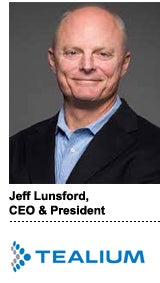This is the ninth in AdExchanger’s “Meet the CDPs” series. Read previous interviews with mParticle, Acquia-owned AgilOne, Amperity, Segment, ActionIQ, Lytics, Bluecore, Microsoft, Optimove, Adobe, Treasure Data and BlueConic.
Evolving into a customer data platform was always part of the strategy for tag management vendor Tealium.
But back in early 2012, when the company closed its $1.1 million Series A – Tealium’s total funding to date is now more than $167 million – the market was a bit too early for CDPs.
“The vision from Day One was to solve the customer data problem,” said Jeff Lunsford, Tealium’s CEO and president. “But we started with tag management as the obvious first application as an on-ramp to the CDP, which is where we’ve evolved over the past five years.”
This year, the number of profiles created using AudienceStream, Tealium’s CDP, has increased by 300% compared with 2019.
Roughly 850 enterprise companies use Tealium’s tag management product, the majority of which have also signed up for AudienceStream. Brand clients include Lufthansa, Cathay Pacific, Wells Fargo, Bank of America, HSBC, News Corp, Dow Jones, The Economist, Macy’s, Sony, Intel, IBM and Cisco. More than a quarter of Tealium’s 500 employees are engineers.
Lunsford spoke with AdExchanger.
AdExchanger: What does it mean to be a CDP during a global pandemic?
JEFF LUNSFORD: Digital-first has been a strategic mandate for many years, but now it’s a truly existential mandate for many businesses around the world. Our job is to help our customers expeditiously migrate to this new world by providing the real-time customer data infrastructure they need. With this in place, they can continue to grow their revenue through digital channels while also reducing the expense of legacy systems that are slow and backward looking.
Why did it make sense for Tealium to evolve from a tag manager into a CDP?
Data fragmentation is a problem we saw emerging across the enterprise as more companies used more and more software packages to create their customer experience and engage with their customers. Our strategy was to be a neutral company with a platform that could collect all of this data, associate it with visitor profiles and then distribute these enriched profiles to all of the software that could benefit from it.
In 2011, when we funded the business, 60% of customer data was coming from websites, so that’s what we started with. At the time, a tag management platform was the best way to help organize all of the vendors on a website in one place.
When did you transition into CDP territory?
We launched our CDP, AudienceStream, in 2013 and our API hub, called EventStream, in 2014, which is designed to collect all of the mobile and server-to-server data you get from IoT devices. That same year we also launched DataAccess, which allows us to be a data warehouse or we can stream data into one.
What data sources do you commonly connect?
We have integrations with 1,300 different partners across mar tech, CRM, ad tech and analytics. It’s all the major vendors and companies, including Adobe, Salesforce, Oracle, Facebook, Google, Twitter, ad networks and DSPs, such as The Trade Desk.
Who is the typical customer for AudienceStream, and what problems are they trying to solve?
We’ve found that companies in all verticals and industries have a problem harnessing their various data sources and understanding the knowledge embedded in all of this data. We work with both B2C and B2B companies and have clients in retail, travel, healthcare, tech, financial services and media. The use cases are a little different for each.
A large airline, for example, might want to bring together data from their website, app, call center, reservation system and loyalty program, while media companies use the technology to track customers across their various properties and to create a universal profile. For example, we help optimize their ad inventory by creating audiences that can help them get higher yield. The financial services companies we work with often use us for data governance.
You raised $55 million in May 2019. Any plans to raise more?
We have plenty of capital right now and we’re not thinking about raising. We’re just growing the business and executing on our business plan.
Does it seem like prospective customers are educated enough about the CDP space?
Everyone is sending out RFPs for CDPs, but they’re all asking for different things. Our job is to drill down into exactly what they’re trying to accomplish and try to be efficient and honest up front as to whether we can help them with that or not.
If they’re trying to automate their email, or something like that, we’re not their guy. But if they’re trying to solve for consistent data across the enterprise, then we most definitely are.
You’ve called the CDP space “annoyingly crowded” in the past. Who are your biggest competitors?
Although all of the major marketing clouds have announced CDPs of their own or something along those lines, we don’t compete with them; we integrate with them. There are more than 100 smaller companies out there and not one of them has risen up as a competitor with an end-to-end platform that sits at the data layer like we do.
But, really, who are your competitors from that list of more than 100?
You’d have to ask them. There are so many companies that claim they should have a seat at the table even if they shouldn’t really be there.
This interview has been edited and condensed.















